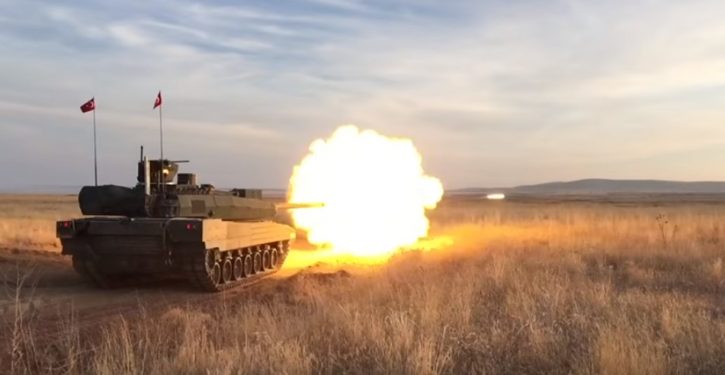
Multiple regional sources reported on Tuesday that Qatar and Turkey have inked an agreement for Doha to purchase 100 new Altay main battle tanks (MBTs) from Turkey, which produces the tank indigenously.
Commentary from Western observers has so far been spotty, curious, and even skeptical. Qatar is a very small country, subsisting in the Persian Gulf on a promontory off the Arabian Peninsula. Main battle tanks, are, well, main battle tanks. They’re used for lethal, terrain-chewing armor warfare on a landscape Qatar doesn’t even have. For the applications you might expect Qatar to plan for, something smaller and more suitable for things like local, mixed-platform defense (e.g., of the emir’s palace and government facilities) and population control would make better sense.
But Qatar has actually been investing in MBTs for some time. In 2013, Qatar signed a purchase agreement with Germany for 180 German-made Leopard MBTs. (Of those, 32 had been delivered by 2016, with 62 more in an active order-delivery process.)
Will this presidential election be the most important in American history?
I wrote about that purchase at the time, pointing out the same things observers are looking at now. What the heck does Qatar need all those tanks for?
In 2013, I suggested a connection between the Qatar tank buy and Saudi Arabia’s $60-plus billion deal to buy major weapons platforms from the U.S. (a deal made in 2010; see Qatar link for a link to an earlier article on that).
If you surveyed what a group of the Arab nations were buying, no single nation would have a comprehensive fighting force for power projection in the Middle East. But if you put their forces together, you’d have most of what you needed for such a juggernaut. (They would have been short on maritime area access/denial assets.)
The threat they would have had in view would be Iran. If they had a target in view, it would have been Israel – in an ultimate sense, although part of having Israel as a target would have been closing in on an Israel-involved battlespace through dealing with the consequences of the Arab Spring of 2011. In either case, it would have been something bigger than local border defense that prompted strategic planning on the scale implied by the huge arms purchases that were cropping up. For such purchases, the Arab nations were envisioning massed, large-battlespace operations.
Regional conditions and priorities were very much in flux in 2013, and it wasn’t unrealistic to suggest that the different weapons buys were looking at a little bit of both: threat and long-term target.
In the years since, however, Iran’s emergence as a very real threat, with game-changing incursions in Iraq, Syria, and Yemen, has tipped the scale toward the Iran-threat motive – at least for the Saudi-allied Arab nations.
But Qatar is not among those nations now. The big rift between Qatar and Saudi Arabia (along with other Gulf nations and even Arab nations outside the Gulf), which opened overtly in 2017, marked a significant change in regional dynamics and conditions. There is little (if any) question at the moment of a combined Arab military posture in which Iran figures as the threat, and Qatar is aligned “hard” – i.e., in terms of military preparation – against Iran.
Qatar is an Iran-friendly quantity in the Middle East equation now. That was the decisive factor underlying the Saudis’ decision to freeze ties with Qatar two years ago.
And with that rift continuing, and Qatar continuing to cooperate with Iran and Turkey in ways inimical to Saudi interests, the regional picture has shifted materially since 2013. In 2014, Qatar and Turkey signed a defense agreement that resulted in a Turkish military base being established on the Qatari promontory. The Saudis have been urging Turkey to close the base, but to no avail. Also in this period, in 2015, Qatar inaugurated conscription for military service – a move long rejected in Doha and the smaller Gulf states.
If you’re Saudi Arabia, you see Qatar increasingly as a source of vulnerability. All it takes is a few minutes with a map to see why.
Think like a military strategist. There are a couple of ways, using conventional forces, to put Saudi Arabia at risk with a direct approach from Iran. And the path on which you can achieve the most surprise (i.e., with rapid movement) runs through Qatar.

If you’re Iran, you don’t want to have to move heavy armor across the Persian Gulf.
But if Qatar stockpiles the heavy armor, you don’t have to.
This consideration no doubt had priority in Riyadh’s plan, reported at various times in 2018, to make the marshy border between Saudi Arabia and Qatar into a canal. It was amusing last year to watch commentators frame this as an act of frivolous pique by the Saudis. When you factor in Qatar’s friendliness with Iran and the 180-tank arms agreement with Germany, you can see exactly why the Saudis want that border to be made of water.
Qatar buying 100 more tanks from Turkey would indicate this overall situation isn’t going in a positive direction. At a minimum, Qatar is positioning herself to be indispensable to the plans of whichever regional actor becomes the big dog. Qatar has unparalleled real estate; becoming a pre-stocked military depot, available to the highest bidder, is a matter of making smart investments.
We’ll see if Iran gets outbid at some point. We’ll see if the Saudis follow through on that canal. (Assuming they do, they can construct it in such a way that it would take some mighty slick combat bridging equipment to get 64-ton MBTs across it.)
Meanwhile, I recommend keeping in mind one of Dyer’s Axioms, developed during my years as a military intelligence professional: “Nobody buys a new army just for the heck of it.”




